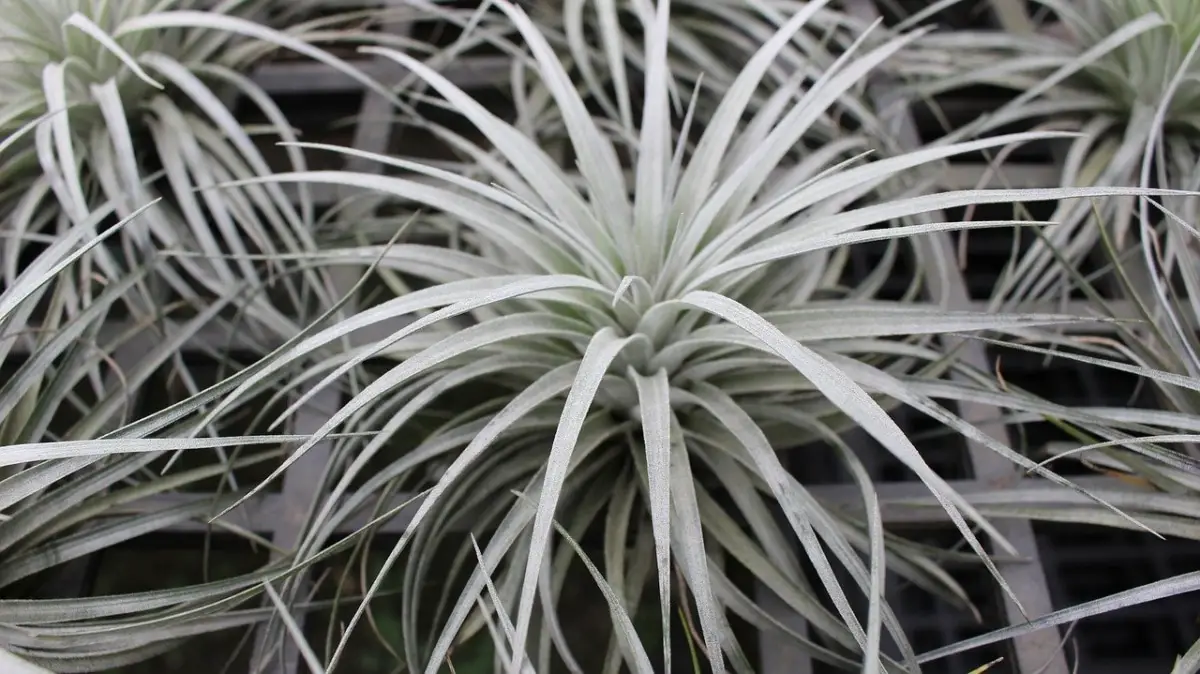
Tillandsia are a genus of bromeliads that live both in deserts and jungles throughout the Americas. As most of them grow on the branches or roots of the trees, which they use only as support, they are called plants from the air, since they obtain water and their nutrients from the air, through the leaves.
There are many types of Tillandsia, although only a few species are on the market. Although they may all seem very similar to you, they are actually classified into two large groups: green tillandsias, which are those that lack trichomes (structures that absorb moisture), and gray ones that do. While the former live in rainy regions, often in shade, the latter prefer sun, in addition to high humidity.
Tillandsia species selection
The botanical genus Tillandsia is made up of more than 600 species, which is why it is considered the most numerous of the bromeliads. The most cultivated are the ones that we are going to show you below:
tillandsia aeranthos

Image – Wikimedia Commons / Harlock8
It is the most common. It is known as air carnation y is a plant up to 10 centimeters tall who lives in the mountains of tropical America. Its leaves have trichomes, and can be greenish or silver depending on the cultivar. It produces flowers that are purplish in color.
tillandsia bergeri

Image – Wikimedia Commons / Lemon
The tillandsia bergeri it is a native species of Argentina. It develops rosettes of greenish leaves and produces purplish flowers that It grows to about 15 centimeters tall. Its growth is very slow, but its cultivation is very simple since it can live without substrate.
Bulbous tillandsia

Image – Wikimedia / Bocabroms
The Bulbous tillandsia It is one of the largest of the genre, since measures up to 25 centimeters tall. Its leaves are bluish-green, but its flowers are pink. It grows wild from Mexico to northern South America.
tillandsia cyanea

Image – Wikimedia / Cliff
The tillandsia cyanea is a bromeliad that is widely grown as a potted houseplant. It is native to Ecuador, and has very thin, green, tapered leaves. A pink or red corduroy inflorescence and lilac flowers emerge from the center of the rosette. Its height is 30 centimeters.
tillandsia ionantha

Image – Wikimedia Commons / James Ho
The tillandsia ionantha It is a native plant from Mexico to Costa Rica with a maximum height of 8 centimeters. Its leaves are green or dark green, and it produces pinkish-reddish inflorescences from which yellow roses sprout.
tillandsia pruinosa

Image – Wikipedia, the free encyclopedia
The tillandsia pruinosa is a flat native to America, which reaches a size of 10 centimeters. The leaves are reddish-brown in color, and its inflorescences are a pretty pink color.
tillandsia recurvata

Image – Wikimedia Commons / James St. John
The tillandsia recurvata It is a species known as ball or chicken hay. It is native to tropical America, where it is most common in Mexico. Its maximum height is 30 centimetersalthough the normal thing is that it does not exceed 14 centimeters. The leaves are glabrous, strongly curved (hence its name). As for the inflorescences, they are purple in color.
Tillandsia stricta

Image – Wikimedia Commons / Timm Stolten
The Tillandsia stricta it is a bromeliad that lives in South America. Grows up to 10 centimeters talland has greenish leaves and reddish-pink inflorescences. The flowers are white.
Tillandsia xerographica

Image – Wikipedia, the free encyclopedia
The Tillandsia xerographica it is the carnation of the air that has the widest leaves. It is native from southern Mexico to Honduras, and is also known as rooster’s foot. It can measure up to 40 centimeters talland its leaves are wide, gray. Its inflorescences are yellow-orange.
Tillandsia care

Image – Wikimedia Commons / Timm Stolten
Now that you know the most common species, and therefore, those that will be easy for you to find for sale, you may want to know what care you have to provide them.
And, yes, they are relatively easy plants to maintain, since as they are epiphytes, there are many that are kept as pendants. But if they do not have high humidity, or if the climate is not suitable, they will not be able to survive long.
For this reason, below we are going to explain the basics you have to know to be able to enjoy them as long as possible:
- Climate and humidity: they grow in humid tropical climates. This means that they do not resist frost, and that in low humidity conditions, such as indoors, we will have to spray them with water -distilled or soft-.
- Location:
- Exterior: these are plants that when kept outside, either in a garden or on a balcony, must be placed in shade or semi-shade. For example, they will be great on the branches of a tree, or on a lattice.
- Interior: in this place you have to find a room in which there is a lot of light. It is also important that it is not placed near the air conditioning or heating, as it will dry out.
- Substratum: the vast majority have very few roots, but even so, when they are grown in pots, it is worth adding pumice alone or mixed with 20-30% peat. In this way, they will be able to grow better.
- Irrigation: more than watering, they should be sprayed, that is, sprinkled with water. This should be done daily during the summer, especially if they are kept indoors. The rest of the year, and more in winter, it is advisable to put containers filled with water around it.
Did you know the different types of Tillandsia?
